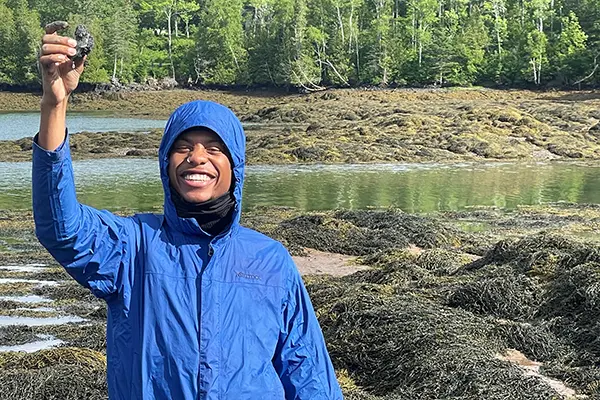Students Gain New Skills in Ecology and Geology While Exploring New England, Montana and Idaho
 Image by Alison Hamilton
Image by Alison Hamilton
08/24/2022
By Brooke Coupal
Nine biological sciences students waded through the waters of Cobscook Bay off the coast of Maine near the Canadian border, studying wildlife during the tidal changes.
More than 2,500 miles west, nine environmental, earth and atmospheric sciences (EEAS) students hiked throughout Glacier National Park in Montana, examining rock formations.
These two field experiences were part of summer courses offered through the Kennedy College of Sciences. Students taking Field Techniques in Ecology with Biological Sciences Asst. Teaching Prof. Alison Hamilton explored fundamental concepts of field ecology in New England, while those taking Geology of North America with EEAS Assoc. Prof. Richard Gaschnig conducted intensive fieldwork in Montana and Idaho.
“It’s so important for students to get hands-on experience; I can’t stress it enough,” says Seven Greer, a rising senior who took Geology of North America.
 Image by Seven Greer
Image by Seven Greer
“One of the overarching goals was to show the students real-world examples of things that they have only read about in class, which makes a big difference,” Gaschnig says.
At Glacier National Park, students looked at sedimentary rocks that represented an ancient sea and learned how to infer the conditions under which the sediments were deposited based on the appearance of the formation.
“We had only described rocks in labs using small samples, but in this course, we were able to actually see the rocks in full scale and have a much better picture of what was going on,” says Daniel LeCain, a rising senior from Westminster, Massachusetts.
At an Idaho State University field station in eastern Idaho, students made geologic maps of a desert butte, a tall, flat-topped rock formation with steep sides. They also visited old mining areas and observed how that operation can alter the land.
 Image by Richard Gaschnig
Image by Richard Gaschnig
“There was no judgment when I wanted to freak out about a rock and how cool it was,” says Libby McGrosky, a rising senior from Pittsburgh, Pennsylvania. “Everyone matched that same excitement.”
Back in New England, students taking Field Techniques in Ecology surveyed aquatic and terrestrial habitats.
“I really wanted to take a class that would allow me to go outdoors and actually experience what a day in my work would be like,” says Gabe Muniz, a rising senior from Brazil who is interested in working in wildlife conservation.
The students kicked off their first week of the course by exploring tidal flats by the Annisquam River, which connects at both of its ends to the ocean in Gloucester, Massachusetts. Campus Recreation accompanied the class during the two-day trip and taught the students how to sea kayak and set up camp. For students like Tyrese Osario, this was their first time camping.
 Image by Alison Hamilton
Image by Alison Hamilton
The students got to go camping a second time when they went to Pawtuckaway State Park in Nottingham, New Hampshire. There, they practiced different methods of collecting ecological data in the forest ecosystem.
They took what they learned over the first two weeks and applied it to final projects that they created while camping at a field station by Cobscook Bay off the coast of Edmunds Township, Maine. The bay is unique because its landscape changes drastically between high and low tide, according to Hamilton.
“We would bring buckets of marine life up to our makeshift lab that I set up, look at them under the microscope, use keys to figure out what they were and see how much taxonomic diversity we had uncovered across the tree of life,” she says. “For most of the students, they had never used a taxonomic key (a tool researchers use to identify an organism) — they barely used a field guide. So, they learned a lot.”
 Image by Alison Hamilton
Image by Alison Hamilton
“It was amazing to watch the students’ confidence and enthusiasm grow,” Hamilton says.
Osario appreciated the field experience because he got to work closely with a diverse group of classmates.
“There were some city kids, like me, who had never been camping, and there were people who were used to being outdoors and had their own hiking sticks and tents,” he says. “It was nice to see people from different backgrounds being brought together through this class. It shows that no matter what people look like, you can always find common ground.”
Hamilton added that it’s important to get students from underrepresented backgrounds interested in science with hands-on experiences.
“Every place we went, it was commented to me that they had never seen such a diverse field course,” she says. “Even though we’re starting to see more involvement of women and minorities in science, some fields, including biology and ecology, are predominately white, and so the opportunity to train students from diverse backgrounds is super unique. We’re lucky to have that opportunity.”
